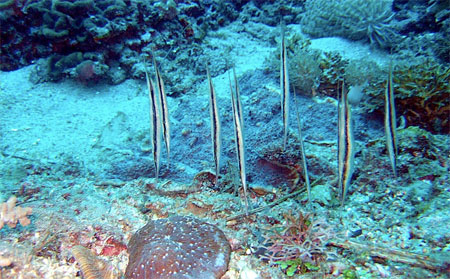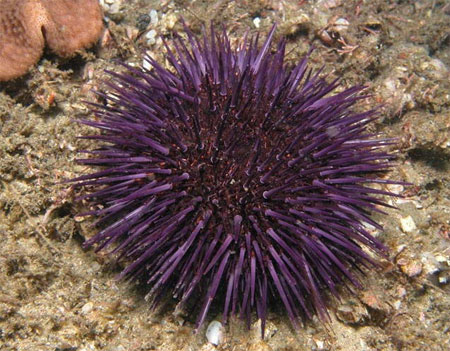Alongside the shores of the Red Sea, connected to the Indian Ocean, lies a very different type of desert world, one that hosts thousands of life forms. Unlike the seemingly endless deserts covered in sand, this one is a desert beneath the sea.
The undersea desert in the Red Sea is one of the most interesting places on Earth. What is most miraculous about these seemingly empty undersea deserts is that, despite their calm appearance, they house a vast and impressive array of sea life. Some of these undersea creatures spend their entire lives hidden in small sea shells, while others adjust to their environment by camouflaging themselves and yet others prefer to hide under the sand.
The brightly colored, diversely shaped and beautiful to look at submarine desert life also captivate us with their special features. The uniquely individual defense and preying methods of each one of these undersea denizens, big or small, are just but a few of the proofs of our Lord’s superior creation.
In this article we shall investigate these fascinating submarine creatures together. Without a doubt, detailed knowledge of the magnificent order of the submarine desert and its members within, will, with Allah’s permission, allow us to know and acknowledge our Lord as His glory deserves while strengthening our admiration as well as our faith. In the Qur’an, our Lord describes the Creation as below:
[He is] the Originator of the heavens and earth. When He decides on something, He just says to it, ‘Be!’ and it is. (Surat al-Baqara, 117)
The Eel That Preys by Casting an Anchor Into the Sand
Galzin's Garden Eel (Gorgasia sillneri), is a type of eel that lives in this submarine desert, and anchors itself to the sand where it nests. The nearly 1 meter long eel fish continually bends forward and backward to catch prey as well as to protect itself from enemies. Upon sensing approaching peril, it retreats into its sand dwelling for protection.
The Black Pearly Razor Fish Plays Dead In the Face of a Threat
The pearly black razor fish is reminiscent of a master warrior; under the sea it applies a different tactic in the face of a threat. For protection from predators, the pearly black razor fish prefers to camouflage itself and immediately lies on its side and opens its back fin. By lying still, motionless on the sand, it resembles a heap of trash. With endless inspiration from Allah Almighty, this living creature camouflages for protection and manages to protect itself from enemies.

Two Living Creatures In Partnership
Two members of the Red Sea’s amazing variety of submarine desert life, a type of rock fish (Sryptocentrus ceoruleopunctatus) and a Mediterranean shrimp (Alpheus) lead a symbiotic life. While the shrimp keeps the entry of the burrow they share clean of debris, the rock fish keeps watch for a potential danger. In case the rock fish senses a threat while the shrimp is on duty, it shakes its body. Upon noticing the fish’s warning, the shrimp takes cover in their burrow. Almighty Allah inspires mutual communication amongst all creatures, creates them with distinct features and is the Creator of the entire universe.
Star Gazer’s Hiding Under the Sand Ploy
Another interesting member of the submarine desert is the star gazer (uranoscopus). This creature camouflages itself to avert danger as well as to catch prey; it essentially becomes invisible by hiding under the seabed any time it wishes. Sometimes all that remains visible above the sand is the fringe on its lips which looks like teeth. In fact, the fringe, created with Allah’s great knowledge, accommodates continuous water flow allowing for respiration.
The star gazer’s fringes, which enable it to stand on the sand, also plays an important role in its hunting. By means of its fringes, which appear as bait to other fish, it can easily draw in its prey.
The glorious Creation in the star gazer are not limited to these. There is an organ behind the tiny upturned eyes of this fish. It can send 50 volts of current through its surroundings with the use of this organ that enables it to spread electrical currents. In this way, it can easily hunt anything that come close to it, and the 30 centimeter star gazer can even swallow prey its own size.
Poisonous Thorns and Master Hunter
Very many of the creatures that live in the undersea desert have vivid, striking colors. One of these is the sea urchin (Astropyga radiate) with its eye-catching colors. This being, which has poisonous and sharp thorns, can protect itself against many enemies. Only a sea creature that can cross this poisonous line of defense can hunt the sea urchin.
The sea anemone (cerianthus) outdoes the poisonous spines of the sea urchin, using its thin and long tentacles around its mouth and to paralyze its prey and render them helpless. At the same time, these pipe-like beings which are relatives to jellyfish and corals, feed by hunting spineless creatures in the undersea desert.



